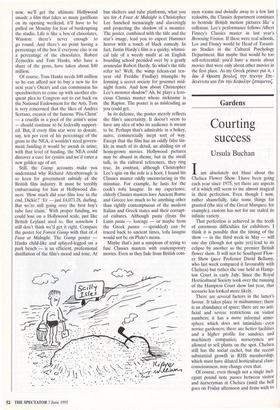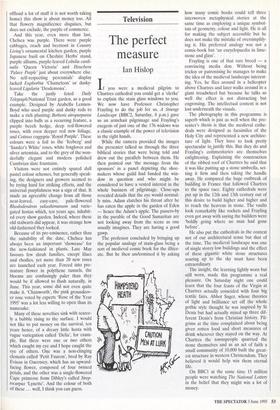Gardens
Courting success
Ursula Buchan
Iam absolutely not blasé about the Chelsea Flower Show. I have been going each year since 1975, yet there are aspects of it which still seem to me almost magical in their perfection. Even though I now, rather shamefully, take some things for granted (the size of the Great Marquee, for example), custom has not for me staled its infinite variety.
That perfection is achieved in the teeth of enormous difficulties for exhibitors. I think it is possible that the timing of the show — in the third week in May — will one day (though not quite yet) lead to its eclipse by another as the premier British flower show. It will not be Southport Flow- er Show (pace Professor David Bellamy, who last week compared it favourably with Chelsea) but rather the one held at Hamp- ton Court in early July. Since the Royal Horticultural Society took over the running of the Hampton Court show last year, that scenario has looked more likely.
There are several factors in the latter's favour. It takes place in midsummer; there is an abundance of space; there are no arti- ficial and severe restrictions on visitor numbers; it has a more informal atmo- sphere which does not intimidate , even novice gardeners; there are better facilities and a higher profile for sundries and machinery companies; nurserymen are allowed to sell plants on the spot. Chelsea still has the social cachet, but the recent substantial growth in RHS membership, which must have diluted horticultural class- consciousness, may change even that. Of course, even though not a single inel- egant pound note passes between visitor and nurseryman at Chelsea (until the bell goes on Friday afternoon and firms wish to offload a lot of stuff it is not worth taking home) this show is about money too. All that flowery magnificence disguises, but does not exclude, the purple of commerce.
And this year, even more than last, Chelsea was purple. There were purple cabbages, orach and beetroot in Country Living's ornamental kitchen garden, purple Japanese basil on Cheshire Herbs' stand, purple alliums, purple-leaved Lobelia cardi- nally 'Queen Victoria' and Heuchera `Palace Purple' just about everywhere else. No self-respecting perennials' display lacked Euphorbia 'Chameleon' or dusky- leaved Ligularia Desdemona'.
Take the justly feted Daily Telegraph/National Trust garden, as a good example. Designed by Arabella Lennox- Boyd who used purple and dusky reds to make a rich planting: Berberis atropurpurea clipped into balls as a recurring feature, a purple beech hedge, deep red-flowered roses, with even deeper red new foliage, and Cotinus coggygria 'Royal Purple'. These colours were a foil to the 'Iceberg' and `Sander's White' roses, white foxgloves and silver artemisia, and to the grey of the won- derfully elegant and modern polished Cumbrian slate fountains.
Visitors were not entirely spared dull pastel colour schemes, but generally speak- ing, the designers and growers seemed to be trying hard for striking effects, and the universal purplishness was a sign of that. It made an agreeable change from all those neat-leaved, easy-care, pale-flowered Rhododendron yakushimanum and varie- gated hostas which, ten years ago, inhabit- ed every show garden. Indeed, where these old stalwarts did appear, it was strange how old-fashioned they looked.
Because of its pre-eminence, rather than the suitability of the date, Chelsea has always been an important 'showcase' for the new-fashioned in plants. Late May favours few shrub families, except lilacs and rhodies, yet more than 20 new roses are launched each year. Forced into pre- mature flower in polythene tunnels, the blooms are confusingly paler than they would be if allowed to flush naturally, in June. This year, some did not even quite make it. 'Chatsworth', the pink groundcov- er rose voted by experts 'Rose of the Year 1995' was a lot less willing to open than its namesake.
Many of these novelties sink with scarce- ly a bubble rising to the surface. I would not like to put money on the survival, ten years hence, of a dreary little hosta with vague variegation called 'Delia', for exam- ple. But there were one or two others which caught my eye and I hope caught the eye of others. One was a non-clinging clematis called 'Petit Faucon', bred by Ray Evison in Guernsey, which has an upward- facing flower, composed of four twisted petals, and the other was a single-flowered Cape primrose from Dibley's called Strep- tocarpus 'Lynette'. And the colour of both of these ... well, I think you can guess.



































































 Previous page
Previous page